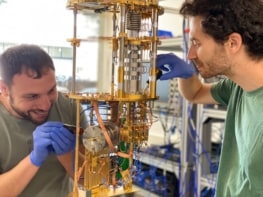
The best measurement yet of the photonic spin Hall effect (SHE) has been made by researchers in the US. The team amplified the normally extremely weak and difficult to detect photonic SHE by measuring polarized light incident on a specially designed metamaterial – a 2D sheet of gold nanoantennas. The researchers suggest that the observed polarization-dependent deflection of the photons could be useful in sensing and communication applications.
Photonic SHE is an optical phenomenon of quantum mechanics that is similar to the more familiar SHE observed for electrons. The spin possessed by an electron is a property related to magnetism – it is a quantized angular momentum that gives rise to a magnetic moment. The electron also has an orbital angular momentum relative to the fixed atoms in the solid, which also results in a magnetic moment. The interaction between the spin and orbital moments – the famous spin–orbit interaction – causes spins of opposite sign to be deflected in opposite directions so that they follow curved paths through a semiconductor. Put simply, the electron’s spin is deflected by an electric field and the SHE describes the curved path that spinning electrons follow through a semiconductor. The curved movement arises from the interaction between the physical motion of the electron and its spin.
Weak effect
Photons also possess spin and so exhibit a similar SHE. But the effect is extremely weak thanks to the fact that photons have a very small momentum compared with electrons. “The photonic SHE is very weak because the spin angular momentum of photons and spin–orbit interactions are basically negligible,” says Xiang Zhang of the Lawrence Berkeley National Laboratory’s Materials Sciences Division, who is one of the authors of the new research, published in Science. He points out that while other experiments have tried to detect the photonic SHE using techniques such as weak measurements, the effect observed has always been very small.
Zhang designs and studies metamaterials – artificial materials specially engineered to have properties not found in nature – and he wondered whether such a material could be used to enhance this weak optical effect. “We looked at specifically making a 2D metamaterial with optical resonators that are very small compared with the wavelength of the incident light and we engineered it to change the gradient of the light to greatly enhance a naturally weak effect to the point where it was directly observable with simple detection techniques,” explains Zhang.
Golden Vs
In the new work, Zhang and colleagues’ metamaterial surfaces are about 30 nm thick and were constructed from V-shaped gold nanoantennas with a geometry that could be configured by adjusting the length and orientation of the arms of the Vs. “We chose eight different antenna configurations with optimized geometry parameters to generate a linear phase gradient along the plane,” says Xiaobo Yin, a member of Zhang’s research group and the lead author of the Science paper. “This enabled us to control the propagation of the light and introduce strong photon spin–orbit interactions through rapid changes in direction. The photonic SHE depends on the curvature of the light’s trajectory; so the sharper the change in propagation direction, the stronger the effect.”
Zhang told physicsworld.com that the researchers had to manoeuvre the light into a “dramatic turn” while incident on the metasurface so that a “giant” photonic SHE would occur. “It’s like riding a bicycle and being forced to make a very sharp and sudden turn,” he says. “It’s the key concept of our idea – to change the direction of the light dramatically, and the V-shaped nanoantennas do that,” he explains. Since the entire metasurface sample measured only 0.3 mm, a 50 mm lens was used to project the transmission of the light through the metamaterial onto a charge-coupled device (CCD) camera for imaging.
Polarization manipulation
Yin adds that their metamaterial allows the researchers to control not only the incident light’s propagation, but also its circular polarization. “This could have profound consequences for information encoding and processing,” he says. He explains that information could be encoded and manipulated into the spin–orbit interaction as well as the polarization of light, “much like the 0 and 1 of today’s electronic devices”. Also, Yin claims that the ability to control left- and right-circular polarization of light at the metamaterial surface should allow the researchers to form optical elements, like highly coveted “flat lenses”, or to manage light polarization without using wave plates.
According to researcher Miles Padgett, of the University of Glasgow in the UK, who was not involved in the work, the new results have some other interesting effects. “The surface ‘Vs’ that the researchers make act as tiny resonators where the emitted light has a different phase to the illuminating light. Changing the angle of the V allows them to change the phase delay and this allows one to make a phase grating that is very thin…less than the wavelength,” he says. He further explains that the new research exploits a difference in behaviour for the two polarization states and so their “grating” imposes a polarization splitting. “What was also interesting to me was that the effect seems to be broadband rather than restricted to a monochromatic wavelength,” says Padgett.
“One of the most important things that our new work shows is that you can manipulate the spin–orbit interaction in photons too…spintronics may not just be for electrons now,” says Zhang.
The research is published in Science.



